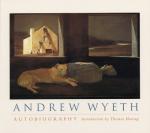|
This section contains 437 words (approx. 2 pages at 400 words per page) |

|
Andrew Wyeth: Autobiography Summary & Study Guide Description
Andrew Wyeth: Autobiography Summary & Study Guide includes comprehensive information and analysis to help you understand the book. This study guide contains the following sections:
This detailed literature summary also contains Topics for Discussion and a Free Quiz on Andrew Wyeth: Autobiography by Thomas Hoving.
Andrew Newell Wyeth (1917-2009) is an artist and realist painter whose work focuses mainly in particularly regions within Maine and Pennsylvania. In the middle of the 20th century, he is one of the best known artists in the United States and wisas sometimes seen as the "Painter of the People" given that his paintings are so popular among the American public. Wyeth frequently paints scenes from his home of Chadds Ford, Pennsylvania and his summer home in Cushing, Maine. While Wyeth paints before the 1940s, it is not until October 1945 that his mature style begins to develop. This consolidation is brought on by the death of Wyeth's father, a person tragedy for him. Wyeth's work comes to be known for its subdued colors, deep realism and the depiction of people or objects with significant emotional impact and symbolism.
Wyeth has several particular locations and people that he likes to paint. For instance, he enjoys painting the Olson family and the Kuerner family. The Olsons are his neighbors in Cushing, Maine and the Kuerner's are his neighbors in Chadds Ford. Wyeth's most famous painting is arguably Christina's World, a picture of Christina Olson lying partly contorted in a field. Christina has some sort of muscular deterioration that paralyzed the lower half of her body and kept her on her family's farm. Wyeth paints her and her brother for twenty-eight years. Wyeth's mature career remains deeply realistic and focused on landscape subjects and models of his favored areas in Pennsylvania and Maine. His walks in the countryside are his main sources of inspiration and gives him an intimate connection with the land and sea and its histories in the area. Wyeth tends to focus on painting in watercolor, dry brush and egg tempera.
When Christina Olson dies, Wyeth starts to paint a girl named Siri Erikson; this a prelude to his famous Helga paintings, when in 1986 Wyeth creates 247 studies of his neighbor, a Prussian immigrant named Helga Testorf. Wyeth's work is often controversial, though not because it is too abstract, like much twentieth century art, but rather because he is a representational artist, trying to capture the real world. Art critics often find him formulaic.
Andrew Wyeth: Autobiography is a collection of over one hundred and twenty of Wyeth's paintings and his commentary on the paintings, primarily on their inspiration. However, the comments also tell the story of his life and his characters; they also illustrate his personality. Thomas Hoving, a former director of the Museum of Modern Art, writes the introduction and the comments recorded in the book are comments Wyeth makes to Hoving.
Read more from the Study Guide
|
This section contains 437 words (approx. 2 pages at 400 words per page) |

|



